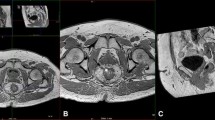Abstract
Introduction. Neoadjuvant radiochemotherapy (neoRT/CT) in locally advanced rectal cancer requires an exact initial determination of the depth of the cancerous infiltration (T-status) and of locoregional lymph node metastasis (N-status).For staging and restaging, contrastenhanced computed tomography (CT) is usually used. In specialised centers, the endorectal ultrasound (rES) may be preferred.
Methods. Between January 1998 and May 2001, the T- and N-status of 102 patients with adenocarcinoma of the rectum (≥T3 or N+) was determined prospectively by rES and CT (group I: n=61 without neo-RT/CT, examined once; group II: n=41 examined before and after neoRT/CT). All diagnostic findings were compared using the (y)pTNMclassification.
Results. In the patients from group I, the depth of infiltration (uT) was predicted correctly by rES in 75% and by CT in 48% of cases; the carcinomas were understaged in 10% and 41% of cases and overstaged in 15% and 11%, respectively.According to the histopathological findings, the N-status was determined correctly by rES and CT in 75% and 57% of cases, understaging occurred in 8% and 30% and overstaging in 17% and 13%, respectively. In cases in which both methods resulted in identical T- (uT+ctT) or N-staging (uN+ctN), the accuracy increased to 82% and 80%, respectively. In patients from group II, after neoRT/CT rES and CT allowed the exact prediction of the yuT-stage in 66% and 51%, respectively.Only 2% were understaged by rES (understaging by CT: 22%).Overstaging occurred in 32% and 27% by rES and CT, respectively.The N-status determined by rES and CT was in accordance with the histopathological findings in 68% and 76%of cases, respectively. Understaging occurred in 20% and 17%,overstaging in 12% and 7%, respectively.Again identical staging results in both rES and CT increased the accuracy of the T- (yuT+yctT) or N- (yuN+yctN) classification to 90% and 83%, respectively. In group II, downsizing of the tumor by more than one T-stage was correctly assessed by rES results in 15/20cases (75%). A complete remission of initial uT3-carcinoma was diagnosed correctly in only two of eight ypT0-cases. In contrast, CT demonstrated a remission of disease in all cases but was unable to predict the extent of tumour reduction. A remission of lymph node metastasis was accurately shown by rES in 17/19 cases (90%) and by CT in 10/12 cases (83%).
Conclusion. The staging of pretherapeutic, locoregional T- and N-status by rES is superior to that by CT (T-status: P=0.0164, N-status: P=0.0035).At restaging, rES offers higher accuracy in the detection of residual tumour infiltration (but not significantly to CT, yT-status: P=0.0833, yN-status: P=0.7962) and assessment of local remission. Therefore rES should be the method of choice in staging to avoid overtreatment in neoadjuvant settings.After neoRT/CT, the predictive efficacy of the rES for the downsizing/-staging of rectal cancer must be evaluated on greater numbers of patients receiving standardised diagnostic procedures and therapy.
Zusammenfassung
Einleitung. Die neoadjuvante Radio-/Chemotherapie (neoRT/CT) des lokal fortgeschrittenen Rektumkarzinoms erfordert eine genaue prätherapeutische Einschätzung der Tumorinfiltrationstiefe (T-Status) und der lokoregionalen Lymphknotenmetastasierung (N-Status): Zum Staging und Restaging wird allgemein die Kontrastmittelgestützte Computertomographie (CT) und in spezialisierten Zentren die rektale Endosonographie (rES) favorisiert.
Methoden. Von 01/98–05/01 wurde bei 102 Patienten (Pat.) mit einem Adenokarzinom des Rektums prospektiv der T- und N-Status per CT und rES bestimmt [Gruppe I: n=61 Pat.ohne neoRT/CT;Gruppe II: n=41 Pat.vor und nach neoRT/CT] und mit dem histopathologischen (y)pTNM-Befund verglichen.
Ergebnisse. In Gruppe I traf die rES-Vorhersage bzgl.der Tumorinfiltrationstiefe (uT) in 75% zu (CT: 48%); 10% (CT: 41%) der Malignome wurden falsch zu niedrig (“understaging”) und 15% (CT: 11%) falsch zu hoch (“overstaging”) eingeschätzt.Der N-Status wurde per rES in 75% richtig erhoben (CT: 57%), das “understaging” lag bei 8% (CT: 30%) und das “overstaging” bei 17% (CT: 13%). In Gruppe II entsprach die rES-Vorhersage einer nach neoRT/CT verbliebenen Tumorinfiltration (yuT) in 66% (27/41 Pat.) dem ypT-Befund (CT: 51%).Lediglich 2% der Pat.wurden im Restaging mittels rES falsch zu niedrig (CT: 22%) und 32% (CT: 27%) falsch zu hoch eingeschätzt.Der yuN-Status entsprach in 68% (28/41 Pat.) der Histologie (CT: 76%), wobei ein “understaging” in 20% (CT: 17%) und ein “overstaging” in 12 % vorlag (CT: 7%). Eine komplette Remission (CR) initialer uT3-Rektumkarzinome wurde in 2 von 8 als ypT0 befundeten Fällen erfaßt.Demgegenüber sagte die CT bei allen 20 Pat. – allerdings ohne Festlegung auf das Remissionsausmaß – einen Tumorregress voraus. Eine CR initial vermuteter N-Infiltrationen konnte bei 17/19 Pat.(90%) per rES und bei 10/12 Pat. (83%) per CT korrekt vorausgesagt werden.
Schlussfolgerung: Bei der prätherapeutischen T- und N-Beurteilung ist die rES der CT deutlich überlegen (T-Status: p=0.0164, N-Status: p=0.0035).Im Restaging ermöglicht die rES eine genauere, jedoch statistisch nicht signifikante Beurteilung der residuellen Tiefeninfiltration (yT-Status: p=0,0833; yN-Status: p=0,7962) und der lokalen Tumorremission.
Similar content being viewed by others
Author information
Authors and Affiliations
Additional information
Dr.T. Liersch Klinik für Allgemeinchirurgie,Georg-August-Universität Göttingen, Robert-Koch-Straße 40, 37075 Göttingen, E-Mail: tliersc@gwdg.de
Rights and permissions
About this article
Cite this article
Liersch, T., Langer, C., Jakob, C. et al. Präoperative Diagnostik beim lokal fortgeschrittenen Rektumkarzinom (≥T3 oder N+) . Chirurg 74, 224–234 (2003). https://doi.org/10.1007/s00104-002-0609-z
Issue Date:
DOI: https://doi.org/10.1007/s00104-002-0609-z




